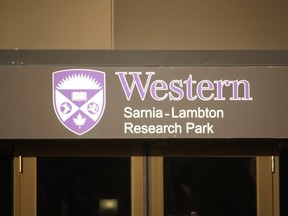
Winners have been announced for this year’s Capstone Engineering and Design Competition at the Western University’s Sarnia-Lambton research park.
More than 50 students from Western’s chemical and biochemical engineering department took part this year, along with a panel of judges from the local community and industry.
“Feedback shared by the engineers, researchers and other community professionals helps to form the future careers of these students,” Katherine Albion, executive director of the research park, said in a news release.
“It is exciting to see the students’ new ideas associated with the future of chemicals and energy production,” she said.
Teams of students spent a day at the research park in Sarnia presenting projects created during the course of their final year at Western.
“In many ways, Capstone is the apex of these students’ learnings and the foundation for their career prospects,” said Albion.
“Exciting discoveries occur all the time in the world of academia and the Capstone competition is an excellent opportunity for students to share in these innovative ideas and learnings with the Sarnia-Lambton community.”
The winners receive financial prizes made possible by more than $11,000 in sponsorship by several companies, as well as the research park.
Created in 2003, the research park is owned by Lambton County through a community development corporation and is made up of lab and research facilities, as well as commercial office space.
Capstone offered prizes in three categories this year: biomass thermochemical conversion processes, carbon dioxide utilization and hydrogen production, and chemical production and resource recovery.
Categories in the annual competition often have connections to Sarnia’s industries.
The winners were:
Biomass thermochemical conversion processes
First: Blue ammonia production from sugarcane bagasse by Adi Venkatesh, Nicole Davies, Jay Sangameswar, Nicholas Sanghera and Jovan Williams.
Second: Forest residues to ethanol via gasification and mixed alcohol synthesis by Austin Dearlove, Jack Woodall, Mia Van Oirschot and Vanessa Benitah.
Carbon dioxide utilization and hydrogen production
First: AquaGen, generating aqua hydrogen through methane pyrolysis by Kaitlin Cacic, Chloe Chong, Monica Perlotto, Ciara Pinto and Cole Beattie.
Second: Utilizing industrial CO2 emissions in the production of green methanol by Abubaker Elneihoum, Vince Jiang, Adam Shubert, Basil Zammo and Michael Zeljeznjak.
Chemical production and resource recovery
First: BAJA ME Ltd. bioethanol fuel production from sugar beet fermentation by Megan Estabrooks, Erin McLean, Brooke Crawford, Jessica Sprunt, Alyssia Burgos and Adam Sawyer.
Second: Co-product recovery from sugarcane bioethanol production by Alexander Law, Andrew Markham, Isabella Parent, Ashley Richard and Mark Soeder.

Comments
Postmedia is committed to maintaining a lively but civil forum for discussion and encourages all readers to share their views on our articles. Comments may take up to an hour for moderation before appearing on the site. We ask you to keep your comments relevant and respectful. We have enabled email notifications—you will now receive an email if you receive a reply to your comment, there is an update to a comment thread you follow or if a user you follow comments. Visit our Community Guidelines for more information and details on how to adjust your email settings.
Join the Conversation